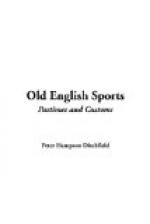Now we come to the diversions of Shrove-tide,[5] which immediately precedes the Lenten Fast. The Monday before Ash Wednesday was called Collop Monday in the north, because slices of bacon (or collops) were the recognized dish for dinner. But on Tuesday the chief amusements began; the bells were rung, pancakes tossed with great solemnity, and devoured with great satisfaction, as an old writer, who did not approve of so much feasting, tells us—
“In every house are
shouts and cries, and mirth and revel rout,
And dainty tables spread,
and all beset with guests about.”
He further describes this old English carnival, which must have rivalled any that we read of on the Continent—
“Some run about the
streets attired like monks, and some like
kings,
Accompanied with pomp,
and guard, and other stately things.
Some like wild beasts
do run abroad in skins that divers be
Arrayed, and eke with
loathsome shapes, that dreadful are to
see,
They counterfeit both
bears and wolves, and lions fierce in
sight,
And raging bulls; some
play the cranes, with wings and stilts
upright.”
But the great game for Shrove Tuesday was our time-honoured football, which has survived so many of the ancient pastimes of our land, and may be considered the oldest of all our English national sports. The play might not be quite so scientific as that played by our modern athletes, but, from the descriptions that have come down to us, it was no less vigorous. “After dinner” (says an old writer) “all the youths go into the fields to play at the ball. The ancient and worthy men of the city come forth on horseback to see the sport of the young men, and to take part of the pleasure in beholding their agility.” There are some exciting descriptions of old football matches; and we read of some very fierce contests at Derby, which was renowned for the game. In the seventeenth century it was played in the streets of London, much to the annoyance of the inhabitants, who had to protect their windows with hurdles and bushes.




